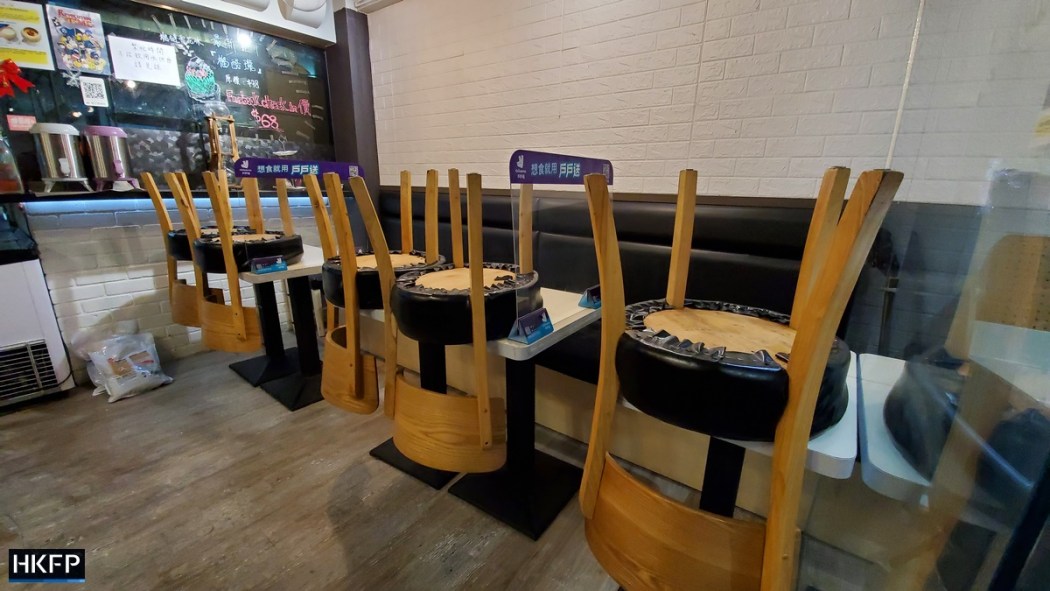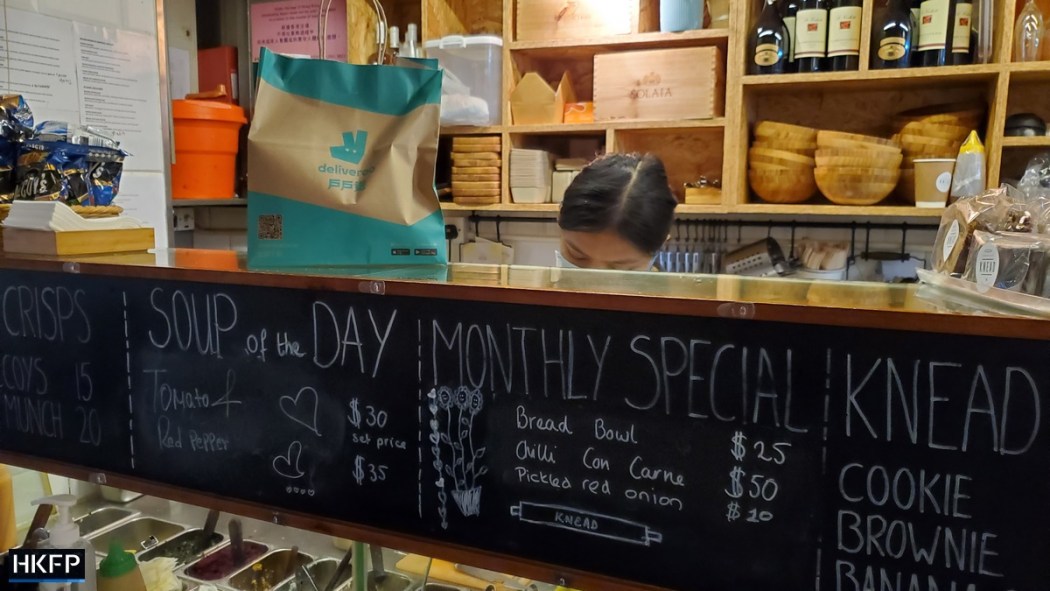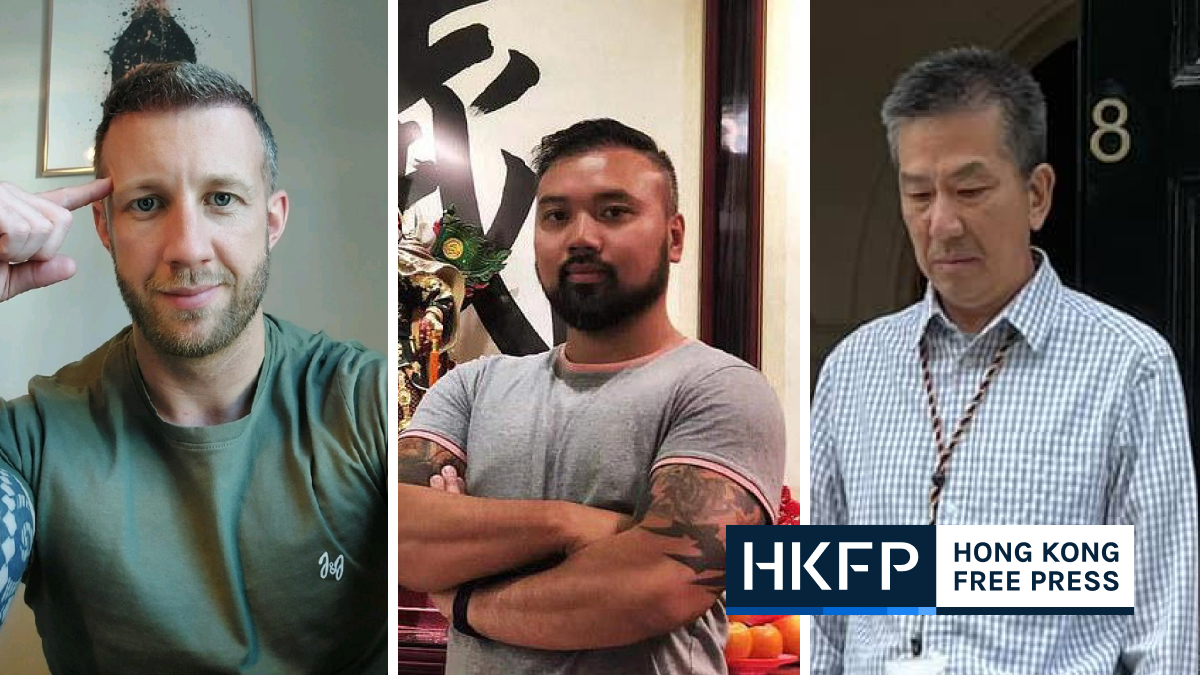On any given weekday evening, Regan Yeung’s yakitori joint in Central buzzes with the post-work crowd. Diners come to his restaurant for the fresh-off-the-grill skewers and stay for the drinks and banter with friends.
But these are no ordinary times. Since early January, when the Hong Kong government banned dine-in services after 6 p.m. due to a new Covid-19 outbreak, Yeung’s restaurant has been empty for dinner.

Some of his regulars come to buy takeaway, breaking the monotony of the otherwise-quiet restaurant. But most of the traffic – in the loosest sense of the word – is a steady trickle of couriers from delivery giants Foodpanda and Deliveroo.
“The commission they charge is steep,” Yeung said, explaining that the online delivery platforms take about 30 per cent from each order that comes via their apps.
Customers, Yeung added, generally do not wonder about what happens behind the scenes. “They just think, ‘Oh it’s a HK$25 delivery fee [for my order].’ But the cost of running these platforms comes from somewhere else. It’s the restaurants.”
Global rise, lasting local impact
Around the world, food delivery – once limited to fast food and pizza – has experienced an enormous rise in recent years. The increase of smartphone users, coupled with user-friendly apps and demand for convenience, have enabled explosive growth. The pandemic has only accelerated the ubiquity of delivery platforms.
While Hong Kong has not endured the Covid-19 lockdowns of many parts of the world, the coronavirus is predicted to have a lasting impact on the city’s food landscape.

Anirban Mukhopadhyay, a marketing professor who researches consumer psychology at the Hong Kong University of Science and Technology (HKUST), said the city’s density and living constraints make it prime for food delivery.
“If we live 30 to 40 minutes’ drive from restaurants, it becomes less charming to order your food and have it arrive cold,” Mukhopadhyay said.
Due to small apartment sizes in Hong Kong, he added, many do not have “massive, functional kitchens” at home. The limitation makes people more inclined to eat at restaurants, or when they are shut, to order takeaway.
With growing reliance on major platforms to bring in orders during these desperate times, restaurants are increasingly at their mercy.

HKFP spoke to half a dozen restaurant owners who said that business from the delivery apps makes up a chunk of their revenue.
But it comes at a price. Foodpanda and Deliveroo, which together command 97 per cent of the city’s food delivery market, charge restaurants around 20 per cent to 25 per cent commission for every order if the restaurants are “exclusive” to the platform and do not sign on with another delivery provider.
If restaurants are “non-exclusive,” meaning they work with more than one delivery platform, they pay rates as high as 30 per cent to 35 per cent.
‘No bargaining power’
Commission rates are not fixed and can be negotiated. But the delivery platforms, which know how reliant restaurants are on their services, have the upper hand, said Jerome Carlier, co-founder of roast chicken takeaway restaurant La Rotisserie.

“We have no bargaining power at all. We are too small,” Carlier told HKFP.
La Rotisserie had multiple locations around Hong Kong before they all closed in January after almost 10 years in operation. Between a drop in lunchtime customers due to work-from-home policies and delivery commissions burning a hole in their revenue, Carlier said the restaurant struggled to turn a profit.
Foodpanda and Deliveroo also offer a pick-up service, allowing customers to order food through the apps and collect it themselves. Restaurants fork out money for these orders, too – about 3 per cent to 8 per cent in commission.
“I don’t think [delivery platforms] should disappear, not at all. They’re very convenient and there are many advantages,” Carlier said. “But you should know what consequences your choice is creating.”

He added: “We’ve seen many of our customers living just above our shop, and just ordering our food with Foodpanda. They don’t realise that half of the profit we used to make with the same order is now going to another company.”
Both Foodpanda and Deliveroo briefly reduced commissions during the height of the pandemic in 2020. In a statement, Foodpanda said pick-up commissions were dropped to 2 per cent in August and September that year. Deliveroo also cut commissions for pick-up orders in April, June and July, the company told HKFP.
But since the latest round of restrictions were enacted on January 7, neither have re-introduced lower rates for restaurants – though there are initiatives to entice customers to spend. Foodpanda, for example, is offering up to 40 per cent off pick-up orders as well as unlimited free delivery for subscribers of Pandapro, the company’s membership program.

“We hope that these offers will help to drive further customer demand, with hopes to bring more orders for our couriers as well as our restaurant and shops partners,” Foodpanda wrote in a statement to HKFP.
‘Ghost kitchens’
It was seeing potential for delivery in Hong Kong – and the fact that the city didn’t yet have any restaurants specialising in poke bowls, a Hawaiian dish made of rice and raw diced fish – that inspired Stephanie Kudus to drop her career in banking and found Pololi.
“We opened in 2014 and we’ve been on any delivery platform since then. We’ve seen them all,” Kudus told HKFP.
Based in Central, Pololi signed on with several delivery providers in its early days, including Foodpanda, Caterspot and Oddle.
When Deliveroo brought its “ghost kitchen” concept to Hong Kong in 2017, Pololi set up shop in its first location in Wan Chai. The shared cooking facilities, called Editions, allow restaurant partners to prepare food in its eight kitchens across the city, thus delivering to a wider geographic area.

Restaurants that work out of the Editions kitchens do not pay rent. Instead, they pay a significant commission of upwards of 40 per cent per delivery order. They are also some of Deliveroo’s most lucrative partners – restaurants that move into an Editions kitchen must make around HK$200,000 to HK$250,000 a month in order to earn a spot, two restaurant owners told HKFP.
“Cloud kitchens create a new growth opportunity for restaurants to tap into. Opening a restaurant can be expensive and risky but with Editions, restaurants are able to pinpoint key locations into which they can expand,” Deliveroo said in a statement. “Given that Deliveroo takes care of ordering and delivery, the restaurants need only to focus on food preparation.”
As part of the deal, eateries that move into ghost kitchens must be exclusive to Deliveroo. Pololi, which occupies three such facilities in Wan Chai, Sai Ying Pun and Quarry Bay, has dropped its partnership with other delivery providers.

“Considering we have three kitchens in Deliveroo’s Editions, I’d say we’re pretty reliant [on Deliveroo.] But this is something I made a call on when we opened the business. Delivery was always going to be our number one sales revenue,” Kudus said.
Still, she wishes that people would be aware of the fees that delivery giants charge, and – where possible – buy directly from businesses.
“I think I can speak on behalf of most restaurants here: come and get your food,” Kudus said. “That would be their way of supporting the industry.”
‘A massive platform’
Restaurants, however, know full well that food delivery giants help them reach customers they otherwise wouldn’t.
“These delivery platforms take a percentage from you, but on the other hand they create a massive platform for us,” said Joosje Hardus, co-founder of sandwich shop Knead.

Also a delivery-oriented restaurant, Knead has seen orders through Deliveroo make up a growing proportion of its revenue since Covid-19 began. Sales now account for up to 40 per cent of their orders, compared to around 20 to 25 per cent before the outbreak, Hardus said.
In addition to its Sheung Wan location, the restaurant moved into Deliveroo’s ghost kitchen in Wan Chai last July. Eateries that work out of these facilities receive more personalised help from Deliveroo, a perk that makes financial sense. As the platform takes a substantial cut from orders prepared in the kitchens, it is in its interest for the restaurants they house to do well.
Hardus sees it as a win-win situation. “They build a relationship with you and work much more with you, like helping you optimise your menu,” she said. “I’m quite happy with them.”
Some restaurant owners, however, are more wary.

Yeung, who owns the yakitori restaurant, said account managers often ask restaurants to join marketing campaigns promising a boost in sales. But convoluted or tricky language can sometimes mean that eateries do not benefit as much as the platforms say.
For example, Yeung explained, the delivery provider might encourage restaurants to offer a 20 per cent discount to attract more customers. But the platform charges commission on the higher, undiscounted price – meaning that while restaurants receive less, the provider will still earn the same.
“There was a time that [Deliveroo] was doing that,” he said.
While delivery platforms cannot force restaurants to take up these marketing incentives, those that don’t stand to lose out.

“When you don’t [join], other restaurants will,” said Yang, the former co-owner of a western takeaway shop who declined to share his first name.
“It’s the algorithm. If you don’t, then you won’t appear in the featured section.”
With one of the highest per-capita concentrations of restaurants globally, Hong Kong’s food scene is one of the world’s most dynamic – and challenging – to operate in. Soaring rents, stiff competition and changing consumer demands are some of the factors hindering business growth. And under the cloud of the coronavirus, restaurant owners admit that their reliance on delivery platforms is a reality they must contend with.
Like many other tech behemoths, delivery giants have capitalised on the pandemic, Mukhopadhyay said.
“These 30 to 35 per cent commissions, that’s what Amazon is doing. That’s what all these big online platforms are doing,” Mukhopadhyay, the HKUST professor, said. “It’s the price of participation.”
Support HKFP | Policies & Ethics | Error/typo? | Contact Us | Newsletter | Transparency & Annual Report | Apps
Help safeguard press freedom & keep HKFP free for all readers by supporting our team

LATEST FROM HKFP
HKFP has an impartial stance, transparent funding, and balanced coverage guided by an Ethics Code and Corrections Policy.
Support press freedom & help us surpass 1,000 monthly Patrons: 100% independent, governed by an ethics code & not-for-profit.










